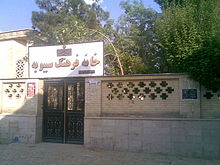ซีบะวัยฮ์
ซีบะวัยฮ์ (อาหรับ: سِيبَوَيْهِ) หรือ ซีบูเยฮ์ (เปอร์เซีย: سِیبُویه; ประมาณ ค.ศ. 760–796) มีชื่อเต็มว่า อะบู บิชร์ อัมร์ อิบน์ อุษมาน อิบน์ ก็อนบัร อัลบัศรี (อาหรับ: أَبُو بِشْر عَمْرو بْن عُثْمَان بْن قَنْبَر ٱلْبَصْرِيّ) เป็นชาวเปอร์เซีย[4][5] ที่เป็นนักไวยากรณ์แห่งบัสราและผู้แต่งหนังสือเกี่ยวกับไวยากรณ์และภาษาศาสตร์ภาษาอาหรับยุคแรก ผลงานที่มีชื่อเสียงของเขาคือหนังสือที่ไม่มีชื่อ (มักเรียกว่า อัลกิตาบ หรือ "หนังสือ") ประกอบด้วยการอภิปรายว่าด้วยภาษาอาหรับจำนวน 5 เล่ม[6]
ซีบะวัยฮ์ | |
|---|---|
 ทางเข้าสุสานซีบะวัยฮ์ที่ชีรอซ | |
| เกิด | ประมาณ ค.ศ. 760 ชีรอซ เปอร์เซีย[1] |
| เสียชีวิต | ประมาณ ค.ศ. 796[2] ชีรอซ เปอร์เซีย หรือบัสรา อิรัก |
| ยุค | ปรัชญายุคกลาง |
| แนวทาง | ปรัชญาอิสลาม |
ความสนใจหลัก | ภาษาอาหรับและภาษาเปอร์เซีย |
ได้รับอิทธิพลจาก
| |
เป็นอิทธิพลต่อ | |
อิบน์ กุตัยบะฮ์ นักวิชาการอิสลามจากตระกูลชาวเปอร์เซียในคริสต์ศตวรรษที่ 9 เขียนชีวประวัติสั้น ๆ ของซีบะวัยฮ์ไว้ว่า:
เขาคืออัมร์ อิบน์ อุษมาน และเขาเป็นนักไวยากรณ์ เขามาถึงแบกแดด ทะเลาะกับนักไวยากรณ์ท้องถิ่น ถูกทำให้อับอาย และกลับไปยังเมืองหนึ่งในเปอร์เซีย และเสียชีวิตในวัยหนุ่มที่นั่น[7]
อิบน์ อันนะดีม และอะบู บักร์ อัซซุบัยดี นักเขียนชีวประวัติในคริสต์ศตวรรษที่ 10 และอิบน์ ค็อลลิกาน นักเขียนชีวประวัติในคริสต์ศตวรรษที่ 13 กล่าวว่า ซีบะวัยฮ์มีส่วนร่วมในความรู้และภาษาศาสตร์ภาษาอาหรับอย่างไม่มีใครเทียบได้ทั้งในสมัยก่อนหน้าและสมัยหลังจากเขา[8][9] เขาได้รับการยกย่องให้เป็นนักภาษาศาสตร์ที่ยิ่งใหญ่ที่สุดในบรรดานักภาษาศาสตร์ภาษาอาหรับและเป็นหนึ่งในนักภาษาศาสตร์จากทุกภาษาที่ยิ่งใหญ่ที่สุดตลอดกาล[10]
ดูเพิ่ม
แก้อ้างอิง
แก้- ↑ Zubaydī (al-) 1984, p. 66, §6 (#22).
- ↑ Mit-Ejmes
- ↑ 3.0 3.1 3.2 3.3 3.4 3.5 Sībawayh, ʻAmr ibn ʻUthmān (1988), Hārūn, ʻAbd al-Salām Muḥammad (บ.ก.), Al-Kitāb Kitāb Sībawayh Abī Bishr ʻAmr ibn ʻUthmān ibn Qanbar, vol. Introduction (3rd ed.), Cairo: Maktabat al-Khānjī, pp. 7–12
- ↑ Danner, V. (1986). "Arabic Language iv. Arabic literature in Iran". Encyclopaedia Iranica, Vol. II, Fasc. 3. Encyclopaedia Iranica Foundation. pp. 237–243.
Persians have been prominent as well in the fields of Arabic grammar, philology, and lexicography. The greatest name in Arabic grammar belongs to the Persian Sībawayh (Sībūya) Bayżāwī (fl. 180/796), whose work, al-Ketāb (The book), remains to the present day the most authoritative exposition of Arabic grammar.
- ↑ Donner, F.M. (1988). "Basra". Encyclopaedia Iranica, Vol. III, Fasc. 8. Encyclopaedia Iranica Foundation. pp. 851–855.
Some of these cultural figures were of Iranian descent, including the early paragon of piety Ḥasan al-Baṣrī; Sebawayh, one of the founders of the study of Arabic grammar; the famed poets Baššār b. Bord and Abū Nowās; the Muʿtazilite theologian ʿAmr b. ʿObayd; the early Arabic prose stylist Ebn al-Moqaffaʿ; and probably some of the authors of the noted encyclopedia of the Eḵwān al-Ṣafāʾ.
- ↑ Kees Versteegh, The Arabic Linguistic Tradition, pg. 4. Part of the Landmarks in Linguistic Thought series, vol. 3. London: Routledge, 1997. ISBN 9780415157575
- ↑ Michael G. Carter, Sibawayhi, pg. 8.
- ↑ Ibn Khallikan (1868). Ibn Khallikan's Biographical. Vol. 2. แปลโดย MacGuckin de Slane, William. London: W.H. Allen. p. 396.
- ↑ Meri, Josef W. (January 2006). Medieval Islamic Civilization, An Encyclopedia. Vol. 1. Routledge. p. 741. ISBN 978-0-415-96691-7.
Of Persian origin, he attached himself in the middle of the second/eighth century to a number of early authorities on the Arabic language in Basra, notably al-Khalil ibn Ahmad and Yunus ibn Habib.
- ↑ Jonathan Owens, Early Arabic Grammatical Theory: Heterogeneity and Standardization, pg. 8. Volume 53 of Amsterdam studies in the theory and history of linguistic science. Amsterdam: John Benjamins Publishing Company, 1990. ISBN 9789027245380
บรรณานุกรม
แก้- Dodge, Bayard, บ.ก. (1970), The Fihrist of al-Nadim A Tenth Century Survey of Muslim Culture, vol. 2, แปลโดย Dodge, B, New York & London: Columbia University Press
- Khallikan (Ibn) (1843), Ibn Khallikan's Biographical, vol. 2, แปลโดย MacGuckin de Slane, William, London: W.H. Allen, pp. 396–9
- de Sacy, Silvestre. Anthologie grammaticale arabe. Paris 1829.
- Derenbourg, H. (ed.) Le livre de Sibawaihi. 2 vols. Paris 1881–1889. [reprinted: New York: Hildesheim 1970].
- Jahn, Gustav. Sībawaihis Buch über die Grammatik übersetzt und erklärt. Berlin 1895–1900. [reprinted: Hildesheim 1969].
- Schaade, A. Sībawaihi’s Lautlehre. Leiden 1911.
- ʻAbd al-Salām Hārūn, M. (ed.) Kitāb Sibawayhi. 5 vols. Cairo 1966–1977.
- Owens, J. The Foundations of Grammar: An introduction to Medieval Arabic Grammatical Theory. Amsterdam and Philadelphia: John Benjamins Publishing Company 1988. ISBN 90-272-4528-2.
- Al-Nassir, A.A. Sibawayh the Phonologist.London and New York: Keegan Paul International 1993. ISBN 0-7103-0356-4.
- Edzard, L. "Sibawayhi's Observations on Assimilatory Processes and Re-Syllabification in the Light of Optimality Theory", in: Journal of Arabic and Islamic Studies, vol. 3 (2000), pp. 48–65. (PDF version - No longer available; HTML version; HTML Unicode version)
- Zubaydī (al-), Abū Bakr Muḥammad ibn al-Ḥasan (1984) [1954]. "§6 (#22)". ใน Ibrāhīm, Muḥammad (บ.ก.). Ṭabaqāt al-Naḥwīyīn wa-al-Lughawīyīn (ภาษาอาหรับ). Cairo: Al-Khanjī. pp. 66–72.
แหล่งข้อมูลอื่น
แก้- Sibawayhi Project contains all significant printed editions of Chapters 1–7, 285–302, and 565-571 of the Kitāb, together with published translations into French and German.
- Sibawayh's Kitāb online in Arabic at al-eman.com.
- Sibawayh's Kitāb online in Arabic (1988, 5 vols., index, cover.)
- Download the Kitāb in scanned format from Internet Archive or Arabic Wikisource
- Sibawaihi's Buch über die Grammatik nach der Ausgabe von H. Derenbourg und dem Commentar des (1900)
- Buch über die Grammatik (1895)
- Buch über die Grammatik (1895)